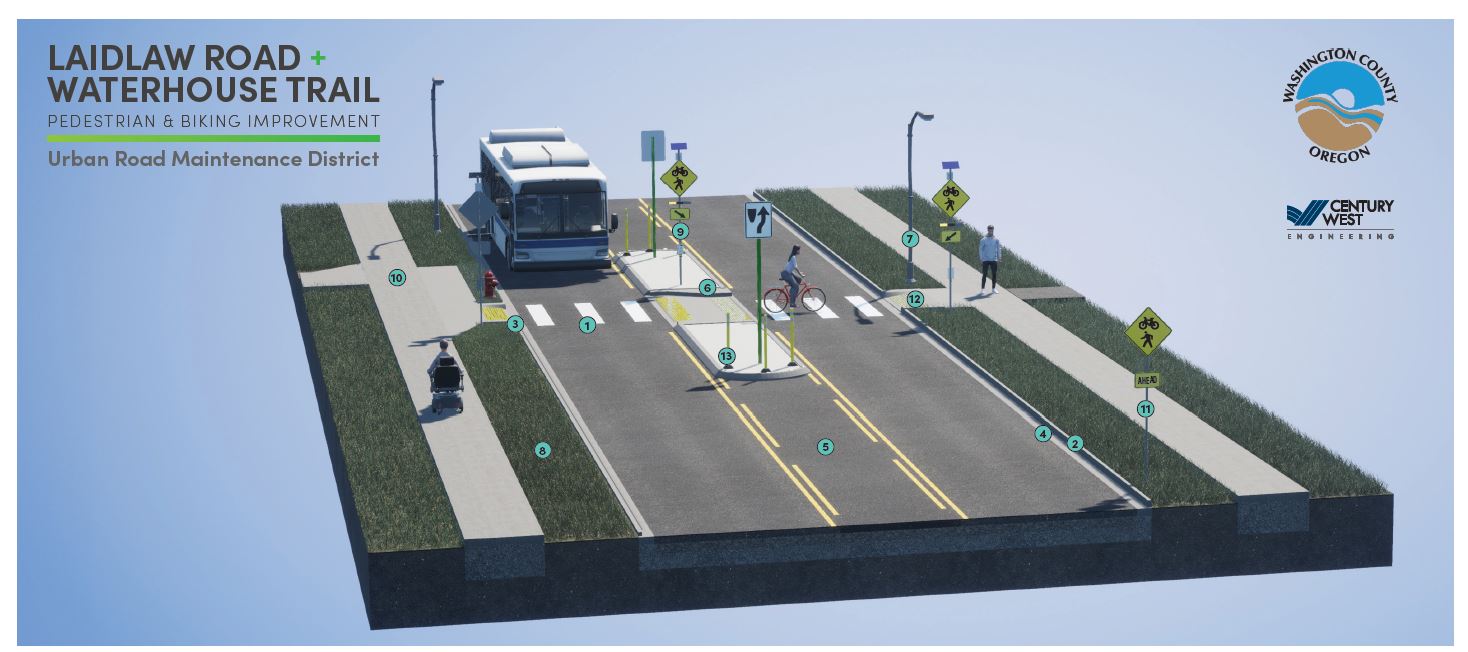This open house is now closed. Please visit the project pages for more information.
Rectangular Rapid Flashing Beacons (RRFBs) can improve safety for travelers crossing the road. RRFBs feature two pedestrian crossing signs that include yellow LED lights which flash when activated. Pedestrians press a button to turn on the lights and increase driver awareness of their crossing.
RRFBs can increase the rate that motorists yield to pedestrians up to 98%, according to the U.S Department of Transportation Federal Highway Administration.
See the general design elements of a road with an RRFB:
 Click to enlarge
Click to enlarge
- Crosswalk: Crosswalks guide pedestrians and signal motorists to yield. This part of the roadway is typically indicated by white or yellow lines extending from curb to curb at intersections.
- Curb: A raised feature often placed along the side of a road, sidewalk, planter strip or pedestrian refuge island that delineates the edge of the roadway or pedestrian circulation path.
- Curb Cut (Curb Ramp): A sloped ramp descending from a sidewalk’s top to a street’s surface, facilitating smooth passage for multimodal users including pedestrians, mobility devices and bicycles. The County designs and constructs perpendicular and parallel ramps to accommodate mobility devices according to the standards established by the Americans with Disabilities Act (ADA).
- Gutter: A channel, often made of concrete or asphalt, that runs parallel to the roadway designed to collect rainwater and direct it to a storm drain.
- Median: A section of the roadway excluding turn lanes that separates opposing traffic. This feature can be paved, planted, painted or raised.
- Mid-Block Pedestrian Island Crossing: Also known as a pedestrian crossing island or refuge island, this structure provides protection for multimodal users between road intersections. Individuals can stop if needed in the central area, waiting for a suitable gap in the opposing traffic before completing the street or roadway crossing.
- Pedestrian Scale Lighting: Light fixtures that are positioned lower (about 12 to 14 feet above the sidewalk) than typical roadway or highway lights. These lights are proportionate to the human dimensions, placed closer together, and are directed toward where people walk, bike or roll.
- Planter Strip: The area between the edge of the curb and the sidewalk. Trees or stormwater facilities are often located in planter strips.
- Rectangular Rapid Flashing Beacon (RRFB): A warning device activated by multimodal users, the RRFB enhances visibility at marked crosswalks, mid-block crossings and areas near schools or trails. It incorporates warning signs and flashing lights to alert motorists approaching the uncontrolled intersections.
- Sidewalk: A pedestrian walkway that is typically between the curb line of the roadway and adjacent property lines. The edge of the sidewalk often abuts curbs, planter strips or roadside ditches.
- Signs: Any device conveying specific transportation information through words or symbols, often placed in advance of approaching traffic control devices or changing traffic patterns. This design includes the following signs: ‘Keep Right’ (white background) and ‘Bicycle & Pedestrian Crossing’ (yellow background).
- Tactile Ground Surface Indicators/Truncated Domes: Installed in sidewalks, roadways and other surfaces, these raised bumps create a detectable warning surface that alert users to the potential of approaching hazards of the roadway.
- Tubular Marker: Permanent markers that are used for the delineation of traffic islands, entryways or wherever special markers are needed.